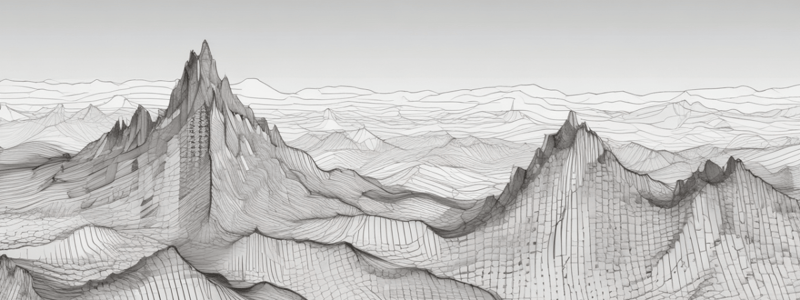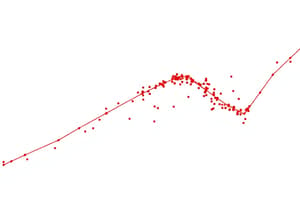Podcast
Questions and Answers
What is the primary purpose of Correlation Analysis?
What is the primary purpose of Correlation Analysis?
- To understand how changes in one variable affect the other (correct)
- To determine the significance of a single variable
- To compare the means of two groups
- To identify cause-and-effect relationships between variables
Which type of correlation coefficient is used for non-linear relationships?
Which type of correlation coefficient is used for non-linear relationships?
- Regression Analysis
- Spearman Rank Correlation Coefficient (correct)
- Pearson Correlation Coefficient
- T-test
What is a necessary assumption for using Pearson Correlation Coefficient?
What is a necessary assumption for using Pearson Correlation Coefficient?
- The relationship is non-linear
- The data points are dependent on each other
- The relationship is linear (correct)
- The variables are categorical
What is an example of a research study that could use Correlation Analysis?
What is an example of a research study that could use Correlation Analysis?
What is the main difference between Pearson and Spearman correlation coefficients?
What is the main difference between Pearson and Spearman correlation coefficients?
What is a potential limitation of Correlation Analysis?
What is a potential limitation of Correlation Analysis?
What is the primary characteristic of the relationship measured by Pearson Correlation Coefficient?
What is the primary characteristic of the relationship measured by Pearson Correlation Coefficient?
Which of the following is a necessary condition for the use of Correlation Analysis?
Which of the following is a necessary condition for the use of Correlation Analysis?
What is the benefit of using Correlation Analysis in a study?
What is the benefit of using Correlation Analysis in a study?
What is the difference between the two types of correlation coefficients mentioned?
What is the difference between the two types of correlation coefficients mentioned?
What is the purpose of collecting data on two variables in a Correlation Analysis study?
What is the purpose of collecting data on two variables in a Correlation Analysis study?
What is the implication of independence of data points in Correlation Analysis?
What is the implication of independence of data points in Correlation Analysis?
What type of relationship is measured by Pearson Correlation Coefficient?
What type of relationship is measured by Pearson Correlation Coefficient?
What is the minimum level of measurement required for both variables in Correlation Analysis?
What is the minimum level of measurement required for both variables in Correlation Analysis?
Which correlation coefficient is used for non-linear relationships?
Which correlation coefficient is used for non-linear relationships?
What is a possible application of Correlation Analysis?
What is a possible application of Correlation Analysis?
What is a necessary condition for the data points in Correlation Analysis?
What is a necessary condition for the data points in Correlation Analysis?
What is a characteristic of the Pearson correlation coefficient?
What is a characteristic of the Pearson correlation coefficient?
Study Notes
Correlation Analysis
- Measures the strength and direction of the linear relationship between two continuous variables.
- Helps in understanding how changes in one variable affect the other.
- Aids in making predictions and guiding interventions.
Uses of Correlation Analysis
- Identifying relationships between variables, such as body weight and blood pressure, drug dosage and patient response, etc.
- Example: Examining the relationship between physical activity and heart health by collecting data on hours spent exercising per week and resting heart rate.
Types of Correlation Coefficients
Pearson Correlation Coefficient
- Measures the linear relationship between two continuous variables.
- Uses the exact value and is parametric.
Spearman Rank Correlation Coefficient
- Assesses the monotonic relationship between two variables, which may not be linear.
- Uses the rank of the value and is non-parametric.
Assumptions of Correlation Analysis
- Both variables are continuous or at least interval-level.
- The relationship is linear for Pearson correlation.
- Data points are independent of each other.
- There are no outliers or influential points.
Correlation Analysis
- Measures the strength and direction of the linear relationship between two continuous variables.
- Helps in understanding how changes in one variable affect the other.
- Aids in making predictions and guiding interventions.
Uses of Correlation Analysis
- Identifying relationships between variables, such as body weight and blood pressure, drug dosage and patient response, etc.
- Example: Examining the relationship between physical activity and heart health by collecting data on hours spent exercising per week and resting heart rate.
Types of Correlation Coefficients
Pearson Correlation Coefficient
- Measures the linear relationship between two continuous variables.
- Uses the exact value and is parametric.
Spearman Rank Correlation Coefficient
- Assesses the monotonic relationship between two variables, which may not be linear.
- Uses the rank of the value and is non-parametric.
Assumptions of Correlation Analysis
- Both variables are continuous or at least interval-level.
- The relationship is linear for Pearson correlation.
- Data points are independent of each other.
- There are no outliers or influential points.
Correlation Analysis
- Measures the strength and direction of the linear relationship between two continuous variables.
- Helps in understanding how changes in one variable affect the other.
- Aids in making predictions and guiding interventions.
Uses of Correlation Analysis
- Identifying relationships between variables, such as body weight and blood pressure, drug dosage and patient response, etc.
- Example: Examining the relationship between physical activity and heart health by collecting data on hours spent exercising per week and resting heart rate.
Types of Correlation Coefficients
Pearson Correlation Coefficient
- Measures the linear relationship between two continuous variables.
- Uses the exact value and is parametric.
Spearman Rank Correlation Coefficient
- Assesses the monotonic relationship between two variables, which may not be linear.
- Uses the rank of the value and is non-parametric.
Assumptions of Correlation Analysis
- Both variables are continuous or at least interval-level.
- The relationship is linear for Pearson correlation.
- Data points are independent of each other.
- There are no outliers or influential points.
Studying That Suits You
Use AI to generate personalized quizzes and flashcards to suit your learning preferences.
Description
Measure the strength and direction of relationships between continuous variables. Understand how changes in one variable affect the other and make predictions.




